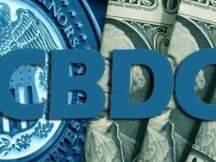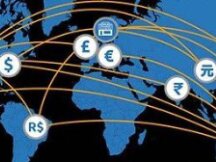An overview of the significant growth and development of the digital banking industry in 2021
2021 is a year of rapid growth for central bank digital currencies. According to BIS Research reported in the third quarter of last year, at least 87 countries around the world are considering abandoning CBDCs, and at least 14 countries including China, Nigeria, the Bahamas and Korea are the driving force. Others. Among them, the Central Bank of Nigeria announced e-Naira in October 2021.
It can be seen that most of the countries currently seeking CBDCs are small and medium-sized countries or countries with new markets, and he believes that the management of the country's capacity and the economy will be affected and negatively affected. by the CBDC. Cryptocurrency and dollar technology have exploded.
The financial system has traditionally included the US and Europe working more cautiously on CBDCs, and there has been no clear announcement that can be estimated in 2-4 years. The dollar is still under investigation by all parties.
Because each country has different backgrounds and advertising goals, existing CBDC solutions can also vary greatly depending on whether or not they use blockchain technology, job, address, etc.
Here is the development status of CBDCs in China, South Korea, Singapore, Japan, Sweden, USA, Bahamas, Nigeria, Europe and other countries and regions, as well as significant progress in 2021.
CBDC guidelines in several countries:
China: Digital Yuan
China was one of the first countries in the world to experience the digital advantages of a mid-sized financial institution, and by April 2020 it had become the first major economy to try digital results. Currently, pilot projects have been implemented in more than 10 cities across the country, with bank transfers to be used by the public from all walks of life, including financial institutions. . In October 2021, with more than 3.5 million digital renminbi pilot scenarios, the turnover reached 62 billion yuan, a total of 14 million people opened digital wallets, and about 1.55 million merchants received a printed portfolio. Payment
Working mechanism:
The digital renminbi has received two-tier operations at the level of "central banks-commercial banks/other entities". The first tier is intermediary banks and the second tier is businesses, consumers, consumers and third-party payment companies.
The banking company plays a key role in the renminbi digital currency, responsible for the wholesale digital renminbi and the overall management life of enterprises, and enterprises and other enterprises are responsible for providing digital renminbi exchanges and services of travel to the public.
The digital yuan is only used for collection and payment and cannot be used to borrow, so there is no interest. The central bank set up a free digital renminbi exchange rate and financial services system, and did not pay the exchange rate and distribute the services of the process, and the bank does not charge the consumer for the ransom in digital yuan and the bond price.
Significant improvements in 2021:
In February 2021, the venture capital firm announced that it was exploring the Multi-Central Bank Digital Currency (m-CBDC) bridge, a multinational wholesale CBDC project, comprising banks between Thailand, the United Arab Emirates and Hong Kong.
In July 2021, the People's Financial Corporation of China released the "White Paper on the Development of Digital Yuan R&D in China", indicating that the R&D experience has begun to complete the superior design, R&D work and debugging. . At the same time, the white paper indicates that the digital yuan can achieve programmability by carrying smart contracts without affecting the performance of benefits.
As of October 2021, renminbi money laundering and fraud scams are common, with many patients and revenues of hundreds of millions of yuan.
In November 2021, the company's CEO, Lee Kang, said that the next step would be to promote the integration of digital and electronic devices in yuan, the integration is secure and convenient, and further improves payment. Privacy, crime prevention and other features.
In December 2021, Shenzhen Agricultural Bank of China and Huawei will implement the first digital RMB cloud-side smart contract scenario. Under the supervision of the rent led by the Shenzhen Urban Rural Housing Development Bureau, through the RMB cloud smart digital contracts, regulations have been put in place, and rents have been guaranteed by regular handover to the supervision in accordance with to the rules. money security.
Singapore: Ubin Project
In 2016, Singapore's CFO launched Project Ubin to explore the use of post-blockchain devices and the distribution of information technology (DLT) for secure payment and withdrawals and pledged transactions. Ubin's ultimate goal is to improve the ease of use and value-added nature of central banking, as the project aims to help Singapore's central bank and industry focus on technology and benefits it can bring from new experiences. Distribute the digital token according to the system.
After several years of development, the Bank of England and Canada, as well as some of the largest technology and financial companies in the world, have joined the mission of Ubin. Temasek, DBS Bank, HSBC, JPMorgan, Citibank, Standard Chartered Banks; Technology partners include Accenture, R3 Alliance, IBM, ConsenSys and Microsoft.
Working mechanism:
Singapore Financial Institutions (MAS) has started to focus on wholesale CBDC research and has not yet started planning for mid-market digital currency research by 2021. big CBDCs are usually about settling and eliminating financial mishaps. Wholesale CBDC customers are typically large financial firms, so user numbers are low and implementation is easy. However, wholesale CBDCs can better utilize blockchain technology to maximize the profitability of financial companies.
The payment network model developed by MAC in partnership with JPMorgan and Temasek will continue to be a network attempt to facilitate partnerships with other central banks and financial institutions to develop the standard cross-border payments layer. To further support the development of the project, a special version of the Ubin Project prototype network and interconnection specialization has been released, and the Singapore government continues to help Ubin Project participants learn how to use these courses.
Major developments in 2021:
In June 2021, financial institutions in Singapore announced the Global CBDC Partnership and Implementation Initiative (OECD) in partnership with the International Monetary Fund, World Bank, Asian Development Bank and other organizations to find a new CBDC solution for retailers and improve payment. Make it profitable and encourage fundraising. The 15 finalists will connect with global leaders/industry experts and gain access to the APIX Digital Results Sandbox to quickly test digital currency solutions.
In July 2021, the Banque de France (BdF) and the MAS announced that they had concluded wholesale trade agreements with foreign countries and the CBDC. This experiment, sponsored by JPMorgan's Onyx, simulates cross-border with several CBDCs (m-CBDCs) in a joint venture between Singapore and France. This experiment is the first m-CBDC test to be used for cross-border payments and solutions through the use of commercial products and management activities.
In November 2021, the Financial Services Corporation of Singapore (MAS) announced the launch of Project Orchid, a mid-sized digital currency retailer. MAS identifies potential applications for retail CBDCs, including the digitization of payments, including funding to support individuals and start-ups, and potential competition from stablecoins and other national CBDCs.
Kauslim
The Korean financial institution announced a 22-month trial in April 2020 to study the legality and impact of CBDCs.
Working mechanism:
Digital results are provided by the Bank of Korea and are filled in electronic form, unlike pre-deposit and term deposit, and its procedures are usually based on DTL (Distributed Ledger Technology). Like the digital yuan in Korea, the Korean Financial Corporation is in charge of publishing and recycling digital assets, and the private company is in charge of distribution, and the funds that hold the digital and data services are managed by the blockchain.
A Bank of Korea employee said, "The CBDC test can be regarded as a financial process." There are some restrictions on advertising and exporting CBDCs directly to individuals or companies without going through financial institutions, so the Bank of Korea used the fraudulent distribution of financial institutions such as cash.
Key progress for 2021:
By 2021, the Korean government will pay more attention to the cryptocurrency and CBDC industries and support the use of CBDC.
The Korean finance company will select the technology company from the tender opened in May 2021 to develop a digital payment platform. The test will run from August 2021 to December 2021. This announcement comes after the Bank of Korea overcame some offline communication issues.
On July 20, 2021, the Korean Financial Corporation announced that it would partner with Ground X, a subsidiary of internet company Kakao in Korea. Although the CBDC pilot project is ongoing, the Bank of Korea has yet to comment on whether to exit the CBDC after the trial ends.
Japan
The Japanese financial institution began researching CBDCs in early January 2020 and set up a new digital currency operation at the Office of the Clearing House in July to expedite the CBDC feasibility study process. By the end of 2020, Japan's financial institutions are expected to launch digital securities (CBDCs) supported by major corporations and banks by 2023, and he announced that he was preparing a good study on the dissemination of CBDCs.
Working mechanism:
Japanese Digital Currency is a retail/general purpose CBDC suitable for a wide range of end users, including individuals and businesses. With features such as cash (like banknotes, coins), end users can use their smartphones or smart cards to make daily purchases at the central bank deposit anytime, anywhere. or. It can also be used as a payment method for joint ventures or finance company financial transactions.
Bank of Japan CEO Shinichi Uchida said if Japan's central bank decides to provide digital services, it will have to engage with private financial services provided by companies. Private banks can be used to create financial services and pay their customers.
Major developments in 2021:
In April 2021, the Financial Services Corporation of Japan announced that the CBDC had announced the launch of the first phase of its Central Bank Digital Currency (CBDC) trial. PoC).
In July 2021, Hideki Murai, Chairman of the Japan Digital Currency Board, told the media that by the end of 2022, the approval of the Japanese CBDC (Central Bank Digital Currency) would be even clearer. .
Thailand
The Bank of Thailand (BOT) met the 3-5 target of the CBDC announcement. After a successful wholesale operation with Hong Kong, the Thai financial institution plans to launch the CBDC driver marketplace by the end of 2022.
Working mechanism:
In 2018, the Central Bank of Thailand's Inthanon project studied only wholesale CBDCs, and in 2021 it began studying retail CBDCs. Our technology partner is Giesecke Devrient. BOT extended the portfolio of CBDC enhancements to consumer products and made two-phase CBDC prototypes in which complex tasks such as bill tokenization and programmable currency are all implemented via smart contracts.
Significant improvements in 2021:
In February 2021, the Central Bank of Thailand, the People's Bank of China and the Central Bank of the United Arab Emirates jointly formed the Central Bank Digital Currency Bridge (m-CBDC Bridge) Research Project to research the application of bank money in the middle. The advantages of cross-border payments.
In April 2021, financial institutions in Thailand announced the digital currency announcement schedule and asked the agency for its opinion on the digital currency markets.
In June 2021, the Financial Services Corporation of Thailand announced that it had contracted German payments giant Giesecke Devrient to develop the CBDC model and allocated 10 million baht for the project.
In December 2021, financial institutions in Thailand announced that they would announce retail central bank digital currency (CBDC) to the public as a payment option by the end of 2022. The experiment is planned for the second quarter of 2022.
Europe: The Digital Euro
The launch of the European Central Bank has slowed, with the digital euro model being developed in 2023 and due to be released between 2026 and 2028. Like the euro, the digital euro is expected to be implemented in most European regions and in numerous countries. as France and Spain seek it.
Significant improvements in 2021:
In February 2021, in the ECB announcement on cryptocurrency regulation, the ECB reaffirmed its commitment to creating digital value over the next four years. According to the data, the ECB wants the digital euro to be exempt from stable privacy laws.
In July 2021, the European Central Bank announced the announcement of the Digital Euro project and conducted the research. The ECB said the digital euro should be able to meet the needs of Europeans, prevent crime and avoid negative effects on financial security and monetary policy. However, the digital euro will continue to operate in place of cash. Over the past nine months, the Eurosystem has implemented several trials of the digital euro, including vigilante, anti-money laundering and anti-distribution restrictions. The ECB said no major impacts were identified during the test.
In September 2021, European Central Bank President Christine Lagarde said in an interview: According to the European solution, research will start in October 2021 and be completed in two years. "
In October 2021, the European Central Bank (ECB) elected an Advisory Board for the Digital Euro project. The group has 30 members from the business world, including members from European and financial companies such as Societe Generale, Nordea Bank, São Paulo Bank, Swedbank, Post Bank and Deutsche Bank. The Commission will inform the ECB of the recommendations and how it may adapt to meet the needs of different sectors in the euro area.
In November 2021, Panetta, President of the European Central Bank, said that by 2023 the digital banking sector will be shrunk and by 2023 it will develop a euro model. In the same month, Panetta said that the digital currency of the euro should be an attractive means of payment, but designed not to become a profitable market that affects banks and private money banks.
Sweden: electronic krona
In February 2020, the Riksbank announced a year-long announcement of the launch of e-Krona, a test developed by consulting firm Accenture. This experiment will simulate the use of e-krona in the "environmental isolation experiment".
Working mechanism:
The digital krone used in the Riksbank pilot project uses blockchain technology and has a "token" mode. Marketing is done through nodes created by the Riksbank and other stakeholders such as suppliers. The service provider may request Swedish Krona money provided by the Riksbank in exchange for users withdrawing their Riksbank account to pay RIX.
Consumers can exchange funds from their bank account for digital crowns and use them for trading purposes. When a digital krone trader, the center service provider verifies that the digital krone can be tracked to the Riksbank. The e-krona is once the consumption and commercialization is completed.
Major improvements in 2021
In February 2021, Riksbank e-krona continued its experimental work until February 2022 to improve technology solutions focused on performance, efficiency, nature and experiences work offline, and will be expanded to include participants such as enterprises. .
In April 2021, Mithra Sundberg, director of the Riksbank's e-krona pilot project, said that a new law would be needed before Swedish CBDCs could come into effect. Given the problems that the electronic krone must solve before it can enter full swing, bank leaders will continue to do so until 2026.
In September 2021, Riksbank Vice President Cecilia Skingsley said digital banking e-krona was unlikely to emerge in five years.
United States: digital dollar
The United States released the Digital Data Transmission (DDP) white paper in May 2020, but has yet to announce its full implementation regarding CBDCs. And with two protesting voices inside, it remains to be seen whether the Fed will announce the CBDC.
In February 2021, Fed Chairman Powell said digital currency was a "most important" project and that the Boston Fed was working with MIT on digital currency research. Powell also said that while digital benefits can help improve financial inclusion, they pose the same risk as damage to a bank.
On May 3, 2021, the American non-profit organization Digital Dollar Project launched five self-portraits and announced that it would begin operations.
On May 20, 2021, Fed Chairman Powell said in a video that he was carefully considering whether the United States should release digital currency and hoped the Fed would take significant responsibility in the development of international standards for CBDCs. . It can be cash and cash. More than converting dollars to digital form.
On June 28, 2021, Federal Reserve Treasurer Randal Quarles warned against reporting CBDC in the United States. He cited ignorance of the implications behind CBDCs, arguing that the costs and risks are so high that they could affect the private sector and potentially limit many types of services such as credit and banking transactions.
Bahamas: Sand Dollars
The Bahamas is believed to be the first country in the world to announce the CBDC, and the central bank launched the national sand dollar in October 2020, but in fact it is still in the trial stage and has not been released. NZIA, an exchange provider, is the country's leading technology provider for digital broadcasting.
In the first phase, private organizations such as banks and credit unions developed consumer identification procedures and other verifications based on the low personal and professional value of the business portfolio. The second sand dollar period is scheduled for mid to mid 2021 and will focus on government planning and private sector support (such as electricity) for CBDCs.
In February 2021, the Central Bank of the Bahamas partnered with payment giant Mastercard to launch the "Sand Dollar Prepaid Card", a bank card that supports digital banking. You pay for goods and services.
In March 2021, the Central Financial Institution of the Bahamas announced that digital banking company "sand weary" was on track to complete the integration of multiple wallets within a week.
Nigeria:e-nra
On October 25, 2021, the Central Bank of Nigeria announced the launch of its digital bank e-Naira, developed by technology bank Bitt. The National Bank's digital bank has yielded a lot in response to the low value of the currency. The Naira price fell 52.12% from $0.0050 in June 2016 to $0.00239 in September 2021, according to TradingView. The reviews argued that e-Naira could improve the ability of governments to implement community outreach programs and increase government remittances.
eNaira uses blockchain technology, digital assets are stored in special wallets and can be used for payments, digital exchanges and almost zero exchange rates. The Central Bank of Nigeria manages access to eNaira. Unlike token-based crypto tools, eNaira is, in principle, an account-based mechanism for tracking transactions.
Financial institutions in Nigeria have banned daily trading and balance of income from bank deposits to eNaira wallets, reducing the impact on trading businesses and other financial firms. Reduce the risk of using eNaira for financial crimes by using a hierarchical authentication system.
The Central Bank of Nigeria announced that it announced 500 million naira (approximately $1.21 million) in digital dividends for financial institutions in October 2021 on the platform.
Ukraine:
Ukraine's financial institutions have been exploring the country's ability to release digital currency since 2016, making it a success in 2021, paving the way for the release of digital currencies at the technical and legal level and is also one of the rare countries. A country is about to announce the digital benefits of public channels.
In January 2021, the bank signed a Memorandum of Understanding (MOU) with the Stellar Development Foundation (SDF) to support the development of CBDCs in Ukraine.
In July 2021, the President of Ukraine announced "financial services". Signed 1591-IX. The law gives Ukrainian banks the right to publish digital currencies and establish a control sandbox to measure payments and devices based on: electronic money.
In December 2021, Tascombank, one of the oldest companies in Ukraine, will attempt to design and develop the Stellar e-hryvnia network and distributed through Bitt's Digital Currency Management System (DCMS), the global platform financial technology. The driver attempted to measure the effectiveness of digital benefits in public payroll, peer compensation, and merchant payments.
Australie: UAS
Tony Richards, the RBA's Director of Payments Policy, said in November 2021 that the RBA had enhanced its research on CBDCs to provide all the evidence that could justify the announcement of retail CBDCs, but RBA staff are still working hard to implement the above CBDCs in Australia. . . It is a strong law.
In December 2021, RBA Vice President Michele Bullock acknowledged that low interest rates were a key driver for the rise of cryptocurrencies and that the RBA was looking to "create average results" for trading. wholesale.
Lithuania:LBCOIN
In July 2020, Lithuania became the first country to declare digital benefits in the euro region, and Lithuania called its digital benefits LBCOIN. Technically, LBCOIN is a CBDC based on the NEM blockchain issued by the Central Bank of Lithuania, but financial companies prefer to call it "the world's first blockchain-based coin pool". In May 2021, the Lithuanian bank announced 24,000 joint ventures developed using blockchain technology. When purchasing LBCOIN, the customer receives 6 digital random symbols, each containing 20 images of old Lithuanian photographs signed in the 1918 Declaration of Independence.
“LBCoin could be the ultimate test site to try out different incarnations of CBDC as central banks start focusing on digital currency,” said Yukilas, Deputy Governor of the Central Bank of Lithuania.
Canada: Project Jasper
Project Jasper Canada is a medium-sized financial institution that works with private companies to participate in digital technology research (DLT). The development of Jasper is divided into 4 stages. In this project, Canada's financial institutions examine the application of DLT for high interest rate payment solution, test the advantages of DLT technology to eliminate and determine bank accounts, and compare digital benefits with other other assets such as currencies. To do. And the potential benefits of securities consolidation are working with the Monetary Authority of Singapore and the Bank of England to establish a cross-border financial arrangement for the next phase of the experiment.
In July 2021, the Treasury of Canada released data showing that CBDCs could be profitable and generally valid for all of Canada and could be a more competitive policy reducing the cost of existing network marketing.
In October 2021, Timothy Lane, Vice President of the Bank of Canada, said during a virtual conference organized by Washington: sharing their own digital advantages. "
India: Numerical Rupee
India is exploring the pros and cons of CBDCs along with cutting-edge technology and developing a way to implement CBDCs. In August 2021, the RBI announced that it would focus on studying the safety and impact of the RBI on financial markets, financial regulation and economic benefits, and consider the pros and cons of the technology selection in product support and distribution. Proof of concept based on the results of a study on the digital rupee.

Scan QR code with WeChat










